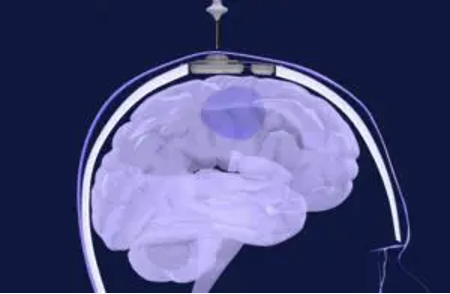Researchers use skull-implantable ultrasound to help deliver chemotherapy to the brain
May 7, 2023
Source: drugdu
 296
296
By Sean Whooley Leave a Comment

[Screenshot from video provided by Nortwestern Medicine]
Northwestern Medicine shared results from a first-in-human clinical trial for a skull-implantable ultrasound device that supports chemotherapy delivery.
The device opened the blood-brain barrier to repeatedly permeate large, critical regions of the human brain. This enabled the delivery of chemotherapy injected intravenously.
With the patient awake, a four-minute procedure opens the blood-brain barrier and patients go home after a few hours. Results from the Northwestern study demonstrated both a safe and well-tolerated treatment. Some patients even reached up to six cycles of chemotherapy treatment.
The paper published on May 2 in The Lancet Oncology.
More about the chemotherapy study
The researchers say this marks the first study to successfully quantify the effect of ultrasound-based blood-brain barrier opening on the concentrations of chemotherapy in the human brain. Opening the blood-brain barrier led to approximately a four-to-six-fold increase in drug concentrations in the human brain. The scientists saw this increase with both paclitaxel and carboplatin. These drugs normally aren’t used to treat these patients because they don’t cross the blood-brain barrier under normal circumstances.
Past studies injected paclitaxel directly into the brain with promising signs of efficacy. However, investigators associated direct injection with toxicity, such as brain irritation and meningitis.
The current chemotherapy used for glioblastoma, temozolomide, crosses the blood-brain barrier, the researchers say. However, it’s a weak drug, according to lead investigator Dr. Adam Sonabend.
“This is potentially a huge advance for glioblastoma patients,” said Sonabend, an associate professor of neurological surgery at Northwestern University Feinberg School of Medicine and a Northwestern Medicine neurosurgeon.
According to the team, it’s also fhe first study to describe how quickly the blood-brain barrier closes after sonication. Most of the restoration takes place in the first 30 to 60 minutes post-sonication. This could enable the optimization of the sequence of drug delivery and ultrasound activation, maximizing drug penetration into the human brain.
The researchers say using ultrasound and microbubbles to open the blood-brain barrier is transient. Most of the blood-brain barrier integrity is restored within an hour after the procedure in humans. Previous studies showed restoration 24 hours after brain sonification.
“There is a critical time window after sonification when the brain is permeable to drugs circulating in the bloodstream,” Sonabend said.
Next steps
The researchers plan to use these findings as the basis for an ongoing phase 2 clinical trial evaluating patients with recurrent glioblastoma. They aim to investigate whether a combination of paclitaxel and carboplatin — delivered through their technique — prolongs survival.
In the phase 1 trial, patients underwent surgery for resection of their tumors and implantation of the ultrasound device. They began treatment within a few weeks after implantation.
Scientists escalated the dose of paclitaxel delivered every three weeks accompanying the blood-brain barrier opening. Studies also evaluated a subset of patients to investigate the effect of the ultrasound device on drug concentrations. Using fluorescein and MRI obtained after ultrasound therapy, the investigators visualized and mapped the blood-brain barrier.
“While we have focused on brain cancer (for which there are approximately 30,000 gliomas in the U.S.), this opens the door to investigate novel drug-based treatments for millions of patients who suffer from various brain diseases,” Sonabend said.
By editor
Read more on
- Breaking the Mold and Forging a New Path! From Insulin Technology Pioneer to Global Innovation Competitor December 4, 2025
- A subsidiary of Kingfriend Pharmaceutical Co., Ltd. has received FDA approval for its self-developed injectable dapavancin December 4, 2025
- Major ophthalmic new drug successfully completed Phase III trials December 4, 2025
- Simcere Pharmaceutical and Wangshan Wangshui have reached an exclusive licensing agreement for deuterium remidevir hydrobromide for new indications such as RSV infection December 4, 2025
- SAL0140 tablets approved for clinical trials for the treatment of chronic kidney disease December 4, 2025
your submission has already been received.
OK
Subscribe
Please enter a valid Email address!
Submit
The most relevant industry news & insight will be sent to you every two weeks.



